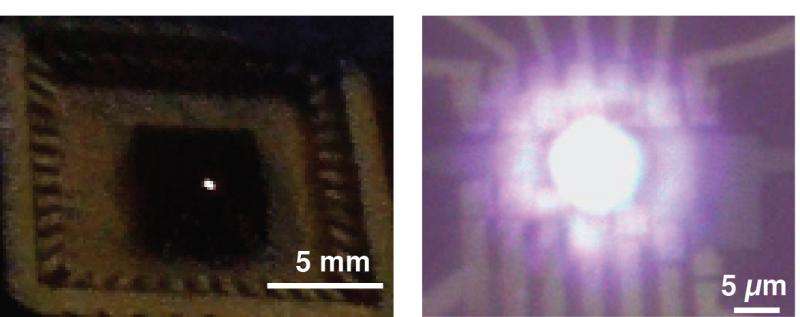A team of researchers from respected educational facilities the world over has reported a successful demonstration of the thinnest light bulb ever created.

The group, led by Young Duck Kim, a postdoctoral research scientist in James Hone's group at Columbia Engineering, includes a team of scientists from Columbia, Seoul National University (SNU), and Korea Research Institute of Standards and Science (KRISS). Together, they’ve detailed the creation of an on-chip visible light source using graphene as a filament.
They were able to achieve this anomaly by attaching small strips of graphene to metal electrodes, suspending the strips above the substrate, and passing a current through the filaments. Doing this, caused them to heat up which, in turn, emitted the bit of light.
“We've created what is essentially the world's thinnest light bulb,” says Hone, Wang Fon-Jen Professor of Mechanical Engineering at Columbia Engineering and co-author of the study. “This new type of 'broadband' light emitter can be integrated into chips and will pave the way towards the realization of atomically thin, flexible, and transparent displays, and graphene-based on-chip optical communications.”
This idea of creating light within small structures aboard a chip is important to the development of fully integrated photonic circuits which, in layman’s terms, do with light what is presently being done with electric currents in semiconductor integrated circuits. There have been several attempts at creating this type of technology, but none have figured out how best to fit the properties of an incandescent light bulb into a chip. That’s because the light bulb filaments must be extremely hot (thousands of degrees Celsius) in order to glow in the visible range; such a high temperature cannot be withstood by micro-scale metal wires. What’s more, heat transfer from the hot filaments to its surroundings is super-efficient at the microscale; this makes such structures impractical. All previous attempts at trying to figure out how best to include a filament on a chip have resulted in damage to the surrounding area.
During their demonstration, the team was able to measure the spectrum of the light emitted from the graphene, and found that the material was reaching temperatures of above 2500 degrees Celsius — hot enough to glow brightly.
“The visible light from atomically thin graphene is so intense that it is visible even to the naked eye, without any additional magnification,” explains Kim, first and co-lead author on the group’s paper.
Worth noting is the fact that the spectrum of the emitted light showed peaks at specific wavelengths — this was due to interference between the light emitted from the graphene and that which was reflecting off the silicon and substrate and passing back through the graphene.
“This is only possible because graphene is transparent, unlike any conventional filament, and allows us to tune the emission spectrum by changing the distance to the substrate,” Kim notes.
What’s also interesting is that the graphene is able to achieve these high temperatures without melting the surrounding substrate or metal electrodes — this is due to the fact that the graphene is an extremely poor conductor of heat. As such, the high temperatures created stay confined to a small “hot spot” in the center.
“At the highest temperatures, the electron temperature is much higher than that of acoustic vibrational modes of the graphene lattice, so that less energy is needed to attain temperatures needed for visible light emission,” Myung-Ho Bae, a senior researcher at KRISS and co-lead author, explains. “These unique thermal properties allow us to heat the suspended graphene up to half of temperature of the sun, and improve efficiency 1000 times, as compared to graphene on a solid substrate.”
In their paper, the team demonstrated the scalability of this technology by realizing large-scale of arrays of chemical-vapor-deposited graphene light emitters. Looking ahead, they will continue to work on further characterizing the performance of these devices (e.g. how fast can they be turned on and off to create “bits” for optical communications), and how to develop techniques for integrating them into flexible substrates.
“We are just starting to dream about other uses for these structures — for example, as micro-hotplates that can be heated to thousands of degrees in a fraction of a second to study high-temperature chemical reactions or catalysis,” Hone adds.
The study, “Bright visible light emission from graphene,” is published in the Advance Online Publication on Nature Nanotechnology’s website.
To learn more, check out the video below:
Via Columbia University: School of Engineering and Applied Sciences
Advertisement
Learn more about Electronic Products Magazine





